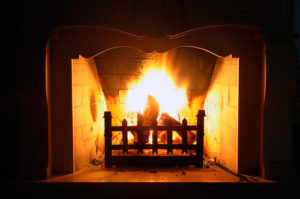With fuel and gas prices on the rise, it’s no wonder that the use of alternative heating fuel sources are also on the rise. Wood burning appliances (e.g. wood burning stoves and prefabricated fireplaces) are more efficient and easy to use than ever. Plus, the home aesthetics that you achieve with a real, wood-burning fire just can’t be topped. However, there are some dangers associated with using a wood burning appliance. Creosote, a natural byproduct of burning fuel, can become a fire hazard if it is allowed to build up to high levels in your chimney. We here at Leonard & Sons want you to know how creosote accumulates in your fireplace and why it’s a hazard. We also want to let you know what your can do to minimize creosote buildup and explain to you why it is so important to sweep your chimney every year.
What is creosote?
Like we said earlier, creosote is a natural byproduct of the fuel burning process. However, although almost all fuels produce creosote, wood usually produces more than other fuel sources such as gas and pellets. When wood is burned, it releases gases in the form of smoke, soot and a mixture of other gases. If a fire isn’t hot enough, less than 1100 degrees fahrenheit, some of these gases aren’t completely burned off. When this happens, some of these gases will cool and condense on the inside of the chimney liner. When this condensation accumulates, it will form a thick black tar called creosote.
Why is creosote hazardous?
Creosote is combustible, meaning it can catch fire and burn easily once it is ignited. Although it takes high temperatures to ignite creosote, once it does light, it is incredibly hard to extinguish. It doesn’t take too much creosote buildup to become hazardous. If fact, it can take as little as ⅛ of an inch to ¼ of an inch of creosote buildup in your chimney for it to become combustable. The National Fire Protection Association (NFPA) estimates annually that there are about 14,000 creosote fires per year which account for nearly 22 percent of all home heating fires, causing $35 million annually in property damage.
Stay safe this winter
Burning wood will always produce creosote, so there is no way to prevent it’s formation. However, there are a few things you can do to protect yourself from creosote becoming a fire hazard. First and foremost, you should have your chimney inspected and cleaned once a year by a Chimney Safety Institute of America (CSIA) chimney sweep. This is the most effective way to minimize the hazards of creosote.
You can also try to slow down creosote accumulation. Hotter fires burn off more of the byproduct and therefore produce less creosote. Using well-seasoned hardwoods as a fuel source will make your fire burn hotter, so try to use these types of wood in your fireplace or stove. Also, try to avoid burning wet or damp wood and softwoods. These type of wood produce more creosote. Keeping your dampers in good working condition will also promote good airflow, which will also keep your fires burning hotter, as well as help gasses escape your chimney faster, giving it less time to condense.
Although creosote can be dangerous, with proper maintenance and good fire burning practices, you can minimize the hazards caused by creosote. If it’s been awhile since you’ve had your chimney inspected, now is the time to get it inspected and cleaned. Our chimney sweeps at Leonard & Sons are CSIA certified and ready to help you make your home a safer place today. Please call us at 847-658-7659 or set up an appointment online today. We look forward to serving you!
